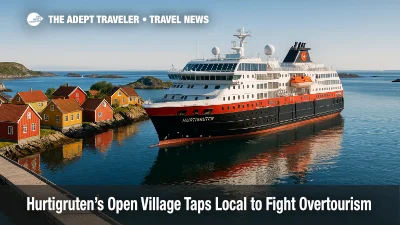Hurtigruten's Open Village Taps Local Life to Fight Overtourism

Hurtigruten is taking slow travel literally. Beginning in May 2026, the Norwegian line's new Open Village concept will fold passengers into daily life in Træna, Bessaker, and Sæbø, three coastal hamlets that each count fewer than 1,000 residents. Instead of crowds and souvenir stalls, guests will help fill a village parade, sip sodd alongside woodcarvers, or hear a church concert performed by locals. Hurtigruten will pay each community about $23 per passenger every visit, ensuring tourism dollars land exactly where travelers step. Company executives say the idea offers a blueprint for destinations wrestling with overtourism across Europe.
Key Points
- Why it matters: Tiny Norwegian towns gain direct income while guests avoid busy fjord hotspots.
- Travel impact: Signature Line itineraries add three remote calls, May through September, on smaller ships.
- What's next: Program success could expand to more villages along the coastal route.
- Direct payout: roughly $23 per guest, per call, no surcharge to passengers.
- Population: all three villages combined host fewer than 1,000 residents.
Snapshot
Open Village rewrites the typical cruise call by placing locals in charge of the agenda. In Bessaker, passengers will follow a village parade to historic boathouses, tasting homemade cake while listening to folk musicians. Sæbø pairs a live church concert with a guided walk through the avalanche research center. On island-speckled Træna, travelers visit a 17th-century chapel, the Petter Dass-inspired prayer house, and the village museum. Hurtigruten's 500-guest ships are the only vessels scheduled to call, limiting footfall while guaranteeing revenue for every resident-led activity.
Background
Norway's fjord ports regularly cap daily arrivals to keep communities livable and ecosystems intact. Hurtigruten, founded in 1893, already touts battery-hybrid ships and bans heavy fuel oil. The line's research found that overtourism pressure now spreads beyond famous hubs such as Tromsø and Bergen, nudging it to re-engineer shore time. By paying villages directly, the company mirrors stewardship models used in polar expedition cruising, where strict visitor quotas protect fragile sites. The $23-per-guest figure, multiplied across a 500-passenger manifest, delivers about $11,500 to a host village in a single afternoon.
Latest Developments
Community-Led Shore Time Sets a New Cruise Template
Hurtigruten confirmed that Open Village experiences will debut on its Signature Line voyages next summer, sailing northbound and southbound legs between Bergen and Kirkenes. Passengers will not pre-book tours; instead, every guest can roam each village at will, guided by residents stationed at local landmarks. Activities range from wood-carving workshops to coffees shared inside fishermen's cottages. All logistics, from crowd control to multilingual signage, are managed by village committees funded through Hurtigruten's per-capita contribution. The cruise line says this approach "reverses the traditional day-tour model" by letting communities pick what to share, while travelers gain a candid view of coastal Norwegian life. Details are published on Hurtigruten's site for future cruisers: Open Villages overview plain-text anchor (https://www.hurtigruten.com/en/about-us/onboard-experience/open-villages?utm_source=adept.travel).
Analysis
Open Village addresses two pain points at once. First, it diverts traffic from Norway's saturated fjord circuit, distributing economic benefits to sparsely populated regions that often watch cruise ships sail past. Second, it builds transparency into revenue flow, a sticking point in cruise economics where port fees and passenger spending seldom filter equally through local economies. By fixing a per-guest payment, Hurtigruten sets a quantifiable benchmark other lines can replicate. The initiative also aligns with rising traveler demand for authenticity, sustainability, and smaller-ship itineraries. For passengers, the absence of up-charged shore excursions removes a common frustration, while curated village stations maintain quality control. Critics may question whether one afternoon can yield meaningful cultural exchange, yet early reactions from regional tourism boards suggest enthusiasm for the cash infusion and global exposure. If Norwegian pilots succeed, similar schemes could surface in Scotland's Hebrides, Croatia's Dalmatian isles, or Alaska's Inside Passage, positioning Open Village as an exportable framework for cruise lines seeking social-license credit.
Final Thoughts
Hurtigruten's Open Village turns the cruise stereotype on its head, swapping megaship crowds for neighborly welcomes and guaranteed local payments. Travelers gain genuine stories, and remote communities capture dependable income. If replicated, the model may prove a powerful antidote to overtourism worldwide, one village visit at a time, anchored by the Hurtigruten Open Village concept.
